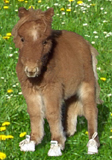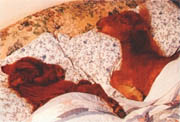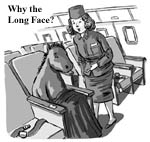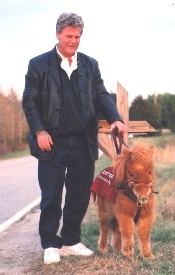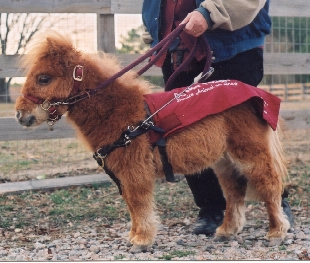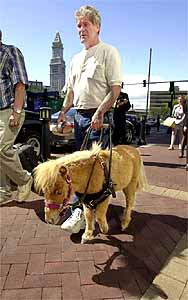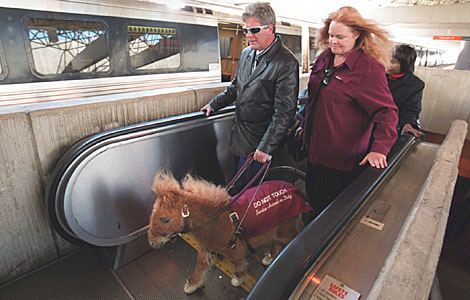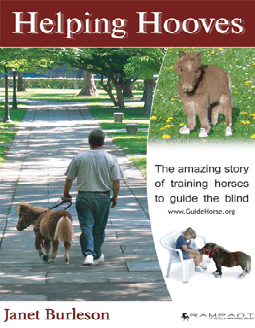A BREED APART
Seeing-eye horse leads the way
Magnolia resident and "Pal" welcome in shops, eateries,
schools
By DEBORAH FLETCHER
Chronicle Correspondent
|
WANT TO KNOW MORE?
|
• Who: Guide Horse Foundation, a nonprofit
group that trains and provides guide horses to people who
are blind and visually-impaired.
• Info: Call 252-433-4755 or visit
www.guidehorse.com.
|
After a lifetime of fighting juvenile diabetes, Donna Grahmann
wasn't willing to give up when blindness overtook her in 2003.
So, the Magnolia woman made a little change in her life. She
got Pal, a miniature horse trained to guide the blind and
visually-impaired in the same way that a seeing-eye dog does.
"I don't have to use someone's elbow or a cane and that's a
good feeling," Grahmann said. "I can do what I need to do
because he can go anywhere. He leads me in the direction I need
him to go and blocks me from obstacles."
The size of a large dog, Pal accompanies Grahmann any place a
seeing-eye dog would go, alerting her to changes in elevation,
surface and obstacles in her path.
A miniature horse must not be taller than 34 inches at the
withers, or point of the shoulder, and if there were no size
reference, the miniature might give the illusion of being a
full-sized horse, according to the Web site,
theminiaturehorse.com.
Grahmann, 44, received the little horse for free from the
Guide Animal Foundation, a nonprofit organization that trains
only the smallest miniature horses, 26-28 inches, to work with
the blind.
Janet Burleson, the trainer and co-founder of the foundation,
said the guide animals must be small so they aren't so strong
that they could accidentally hurt a blind person. They must also
be little enough to get into small spaces, she said.
Burleson said the animals are not meant to replace guide
dogs.
"There are people, like Donna, who show dogs, who might not
want to bring in a dog that would make the other dogs jealous,"
Burleson said.
And some people are allergic to dogs, or are afraid of them.
Most of the horses are donated to the foundation, and people
volunteer their time to train them.
"If it were being done by a paid trainer we estimate it would
cost $30,000 to $35,000," Burleson said.
Burleson said it takes about a year to train the animals,
Once an animal has been paired with a person, the two are
trained together at Burleson's home in Kittrell, N.C., then
again at the home of the recipient.
Since beginning the foundation in 1999, Burleson has matched
one other person with a guide horse. There are 80 people are on
a waiting list, and nine horses are at various stages in their
training, she said.
Pal weighs 151 pounds and stands 29 1/2 inches, hoof to
withers, Grahmann said.
The animal travels in the back seat of Grahmann's
extended-cab pickup truck when family members take them on
outings.
The rest of the time, Pal stays in the pasture or barn with
Grahmann's menagerie of full-sized horse, sheep, chickens, cats
and the border collies that Grahmann shows competitively.
"I didn't want an animal to live in the house, and I don't
need it," Grahmann said. "I know my house. I've got it
memorized."
But, she does need him to guide her in unfamiliar
surroundings. Just last week, Pal helped Grahmann maneuver
through the aisles at the new Target store in Tomball.
"At Target, people kind of gathered around me with their
baskets. Pal blocked me, so I wouldn't run into them," she said.
Often clad in sneakers so he won't slip on slick surfaces,
Pal is an odd sight at the businesses and stores around Magnolia
and Tomball, Grahmann said.
Guide horses must be trained not to urinate, or defecate
indoors, in the same way other pets are, Burleson said.
"You train them just like you do a dog. You reward it from
going in the proper place and discourage it from going in
inappropriate places," she said.
Curious onlookers often slow Grahmann and Pal down with
questions, and many want to pet the horse, even though he wears
a sign, "Do not touch, Service animal on duty," Grahmann said.
Grahmann and Pal are regulars at Denny's, where staff and
patrons have gotten accustomed to them.
"It's unusual to see a horse. People expect to see a dog,"
said Omni Chavez, a server at the Tomball restaurant.
Outfitted with a harness, Pal guides Grahmann through the
restaurant a couple of times a week.
"The animal guides her to the seat, or booth, wherever she is
going to sit. Then he stands very still. He doesn't make a lot
of movements. He doesn't make any noise," said Chavez.
Grahmann said the horse knows he is not on duty when the
handle is resting on his back.
"When the handle on his harness touches his back that means
he's off duty and he's supposed to take a nap," she said.
Being squired about by a horse does have its humorous
moments, Grahmann said.
Once when she was being interviewed at a television station
in College Station, Pal spotted something that interested him.
"He started to nibble on an artificial plant," Grahmann
laughed.
Chronicle correspondent Valerie Sweeten also contributed to
this story.
|
